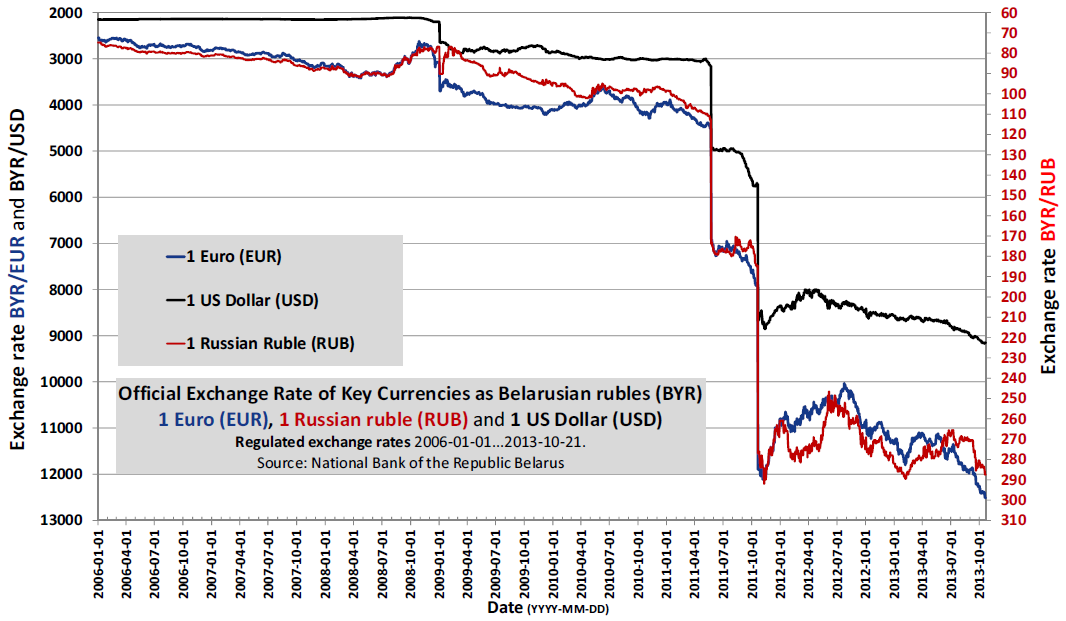Floating exchange rate Wikipedia the free encyclopedia
Post on: 20 Апрель, 2015 No Comment

A floating exchange rate or fluctuating exchange rate is a type of exchange-rate regime in which a currency’s value is allowed to fluctuate in response to market mechanisms of the foreign-exchange market. A currency that uses a floating exchange rate is known as a floating currency. A floating currency is contrasted with a fixed currency .
In the modern world, most of the world’s currencies are floating; such currencies include the most widely traded currencies: the United States dollar, the euro. the Japanese yen. the British pound. and the Australian dollar. From September 2011 until January 2015, the Swiss franc. which had formerly traded via a floating exchange rate, had its floor pegged to the euro. [ 1 ] [ 2 ] However, central banks often participate in the markets to attempt to influence the value of floating exchange rates. The Canadian dollar most closely resembles a pure floating currency, because the Canadian central bank has not interfered with its price since it officially stopped doing so in 1998. The US dollar runs a close second, with very little change in its foreign reserves ; in contrast, Japan and the UK intervene to a greater extent.
From 1946 to the early 1970s, the Bretton Woods system made fixed currencies the norm; however, in 1971, the US decided no longer to uphold the dollar exchange at 1/35th of an ounce of gold, so that the currency was no longer fixed. After the 1973 Smithsonian Agreement. most of the world’s currencies followed suit. However, some countries, such as most of the Gulf States, fixed their currency to the value of another currency, which has been more recently associated with slower rates of growth. When a currency floats, targets other than the exchange rate itself are used to administer monetary policy (see open-market operations ).
§ Economic rationale Edit
There are economists [ weasel words ] who think that in most circumstances, floating exchange rates are preferable to fixed exchange rates. As floating exchange rates automatically adjust, they enable a country to dampen the impact of shocks and foreign business cycles. and to preempt the possibility of having a balance of payments crisis. However, they also engender unpredictability as the result of their dynamism.
However, in certain situations [ when? ]. fixed exchange rates may be preferable for their greater stability and certainty. That may not necessarily be true [ weasel words ]. considering the results of countries that attempt to keep the prices of their currency strong or high relative to others, such as the UK or the Southeast Asia countries before the Asian currency crisis [ original research? ] .
The debate of making a choice between fixed and floating exchange rate regimes is set forth by the Mundell–Fleming model. which argues that an economy (or the government) cannot simultaneously maintain a fixed exchange rate, free capital movement, and an independent monetary policy. It must choose any two for control and leave the other to market forces.
The primary argument for a floating exchange rate is that it allows monetary policies to be useful for other purposes [ citation needed ]. Under fixed rates, monetary policy is committed to the single goal of maintaining exchange rate at its announced level [ citation needed ]. Yet the exchange rate is only one of the many macroeconomic variables that monetary policy can influence. A system of floating exchange rates leaves monetary policy makers free to pursue other goals such as stabilizing employment or prices [ citation needed ] .
In cases of extreme appreciation or depreciation. a central bank will normally intervene to stabilize the currency. Thus, the exchange rate regimes of floating currencies may more technically be known as a managed float . A central bank might, for instance, allow a currency price to float freely between an upper and lower bound, a price ceiling and floor. Management by the central bank may take the form of buying or selling large lots in order to provide price support or resistance or, in the case of some national currencies, there may be legal penalties for trading outside these bounds.
§ Fear of floating Edit

The examples and perspective in this section may not represent a worldwide view of the subject. Please improve this article and discuss the issue on the talk page. (May 2010)
A free floating exchange rate increases foreign exchange volatility. There are economists who think that this could cause serious problems, especially in emerging economies. These economies have a financial sector with one or more of following conditions:
- high liability dollarization
- financial fragility
- strong balance sheet effects
When liabilities are denominated in foreign currencies while assets are in the local currency, unexpected depreciations of the exchange rate deteriorate bank and corporate balance sheets and threaten the stability of the domestic financial system.
For this reason emerging countries appear to face greater fear of floating, as they have much smaller variations of the nominal exchange rate, yet face bigger shocks and interest rate and reserve movements. [ 3 ] This is the consequence of frequent free floating countries’ reaction to exchange rate movements with monetary policy and/or intervention in the foreign exchange market .
The number of countries that present fear of floating increased significantly during the 1990s. [ 4 ]














